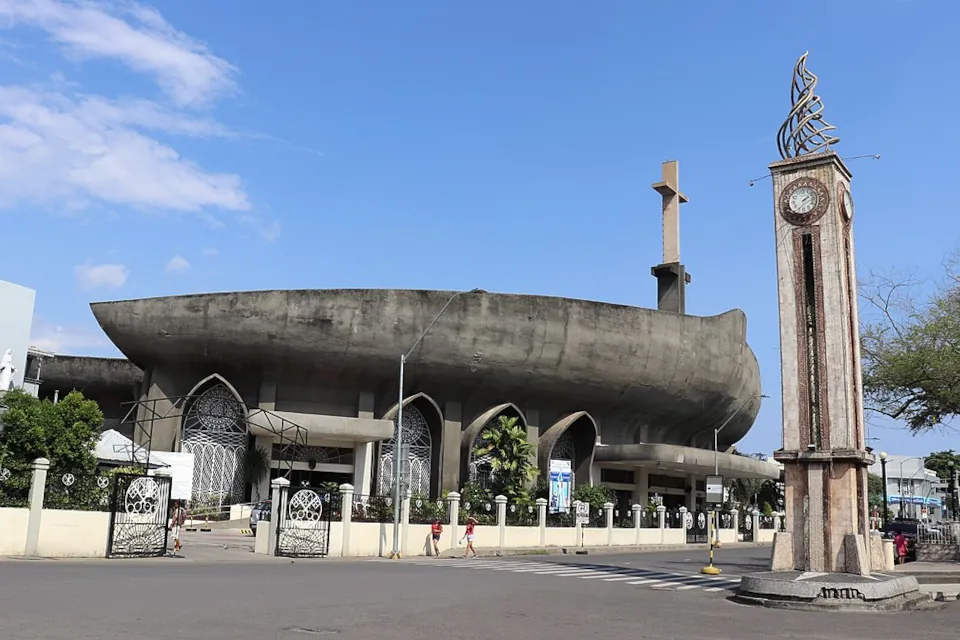 San Pedro Cathedral. (Photo by Teemu Väisänen/Wikimedia)
San Pedro Cathedral. (Photo by Teemu Väisänen/Wikimedia)
A Sacred Symbol in Modern Times: San Pedro Cathedral Through the Eyes of Davao’s Youth
DAVAO CITY — The bells of San Pedro Cathedral toll steadily each day, echoing through the bustling streets of downtown. For 177 years, these chimes have called generations of Davaoeños to prayer, celebration, and reflection. But as Davao City continues to grow into a modern metropolis, one question rings louder than the bells themselves: does San Pedro Cathedral still hold meaning for today’s youth?
Nestled at the heart of the city, San Pedro Cathedral is the oldest church in Davao. Built in 1847, the cathedral has weathered the storms of colonial history, bombings, reconstruction, and rapid urban development. Its iconic ark-like architecture, designed by Architect Manuel Chiew in the 1960s, stands as a symbol of resilience and tradition. Tourists and devout Catholics alike visit daily, but how does this religious landmark resonate with a generation raised in a digital, fast-paced world?
“I don’t visit that often,” says Kian Zik Ner, 20. “Maybe just for occasions like birthdays and such.” For Kian, prayer is personal, something that doesn’t always require a physical church. “I believe you can just pray whenever you like it best,” he adds.
His perspective reflects a broader trend. Young Filipinos are becoming more spiritual than religious. While churches like San Pedro remain important, the rituals of faith are shifting into more flexible, personal expressions.
Still, for others, the cathedral remains more than just a backdrop to city life. Raphael Manigo, also 20, acknowledges that while he attends a nearer church, he still recognizes the cultural and historical weight of San Pedro.
“The San Pedro Cathedral is known for its architectural ingenuity and purpose,” he says. “It’s a beacon of faith for locals and tourists in Davao.”
The structure itself tells stories. Stories carved into its weathered facade, echoed in the murmurs of candles lit in quiet prayer, and carried by families who gather every Sunday morning. For many, it’s a place of memory. For others, it’s a symbol of identity.
Beyond the spiritual, the cathedral plays a key role in Davao’s cultural landscape. From the annual Feast of St. Peter to city-wide processions and outreach events, it bridges generations. “It still plays a major role for Davaoeños because most of the people here are very religious,” Kian reflects. And perhaps that’s where the cathedral’s strength lies, not just in architecture, but in its quiet ability to connect past and present.
Even for those who don’t attend weekly mass, San Pedro remains a recognizable anchor in Davao’s shifting skyline. Students pass by on jeepneys, vendors line up outside its gates, and tourists snap photos of its arched facade. It is both a sacred space and a shared space.
But relevance doesn’t come automatically with age. To stay meaningful to the next generation, the cathedral must engage with youth, not just as a religious institution but as a living part of their community.
“Let them know about the background and history,” Kian suggests. “Especially its importance and relevance here in Davao.”
That may be the challenge and the opportunity. As the city moves forward, so must its most enduring symbols. San Pedro Cathedral doesn’t just represent religion. It represents continuity, community, and culture.
San Pedro Cathedral still matters. Maybe not in the same way it did a century ago, but in ways that are evolving. While not every young Davaoeño attends mass regularly, many still regard the cathedral as a symbol of faith, peace, and Davao’s identity. Its continued impact depends not only on its history but on how it invites the youth to shape its future.
As one generation makes space for the next, San Pedro Cathedral stands. Not just as a relic, but as a reminder that faith, like culture, must be lived, questioned, and passed on. (Amer Lubuguin | ADDU Intern)


No Comments